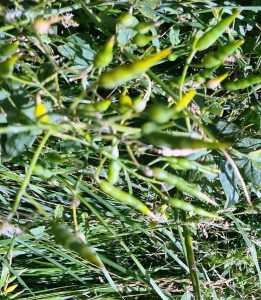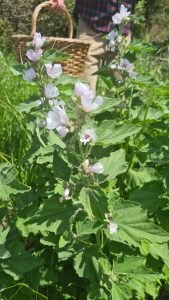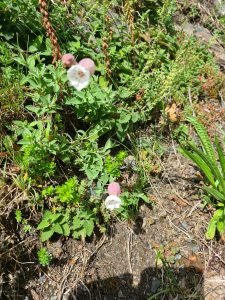July in the woods
It is well into summer now and we are returning to some semblance of normality and the foraging course I booked for July is running. Hurray! This time we were on the seashore rather than in a wood. It was a beautiful sunny day; the beach was packed but we were foraging on the marshes and in the grassy dunes where there we very few people. Which wasn’t surprising as the ground was boggy and uneven with channels of water everywhere blocking your path.

Sea spinach
The plants I saw were very different to those on other walks. They have to survive in a salty environment so tend to be fleshy and tough. One of the first plants we saw was sea spinach, which as its name suggests, can be eaten like spinach. Martin, our foraging guide, had recently made a quiche with it.

Sea radish pods
A plant I am familiar with from my garden and one that keeps appearing in pots when I plant seeds, is fat hen. Also known as lamb’s quarters or White goosefoot (the leaves are shaped like the feet of geese), it is an annoying weed for gardeners but very good for forages as every bit of it is edible. The seeds are rich in starch and can be sprinkled on salads or sprouted and the leaves used instead of spinach or used in salads.
Many of the plants we grow.as vegetables are related to wild versions. Wild carrot and parsnip and the sea radish which was in full radish bloom. You can see why it is called a radish in the picture. These seed pods can be pickled and eaten. Apparently, they taste of radish with a hint of cabbage – lovely!

Marshmallow plant
My favourite plant of the day was the marshmallow. A relative of the common and tree mallow, it is the plant used for cosmetics or in herbal medicine and this is the first time I have seen it growing in the wild. Its flowers are a more delicate pink than its relatives and I was quite taken with it. I use the root in moisturiser as it is soothing and calming and good for dry skin. It is also used for coughs and sore throats as well as inflammation in mucous membranes.
We then moved onto the marshy, uneven, boggy ground where all sorts of lovely plants were growing. The big find was samphire which tastes amazing just eaten fresh picked from the ground.

Sea lavender
It is a small plant so not easily spotted and if you pick it use scissors or your nails otherwise you may pull it up by the root and it is slow growing. Other plants included, seashore aster, lesser sea spurrey and scurvy grass, which tasted better than it sounds. Hidden in among all the other plants is the lovely sea lavender. Smaller than the lavender you find in your garden it is just as fragrant only smaller.
It was a very enjoyable morning and I was extremely glad to be out learning about our native plants.

Sea campion
A new plant for me was the sea campion which I found growing when visiting my sister in Cornwall.
If you don’t live by the seashore there are still lots of lovely plants around. Meadowsweet is out but oddly does not grow in meadows but in can be found where the soil is moist and fertile. It has been used for centuries as a medicinal herb to treat pain as it contains salicylic acid used in aspirin. The July hedgerows are full of tall flowers, pink willow herb and yellow agrimony and tansy and in the shorter grasses you can find selfheal growing with the daisies and bedstraws. Selfheal, as its name suggests, has many uses in herbal medicine. It can be eaten in salads, soups and stews or as a tea and is used to restore the liver or as a tonic for gallbladder.
While visiting the beach why not take a look at the plants growing in the salt marshes and the grass in the dunes. Many of these plants are edible and can be foraged and eaten so why not go out and see what you can find. If you are foraging don’t eat anything you are not sure about as some plants are poisonous or unpleasant to eat.